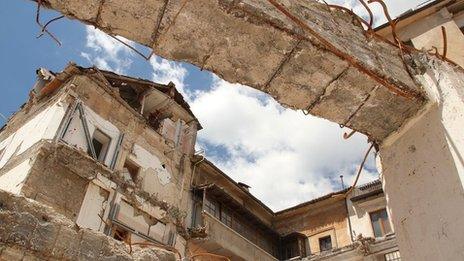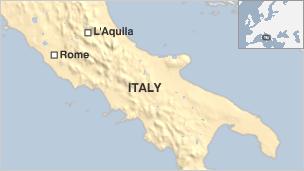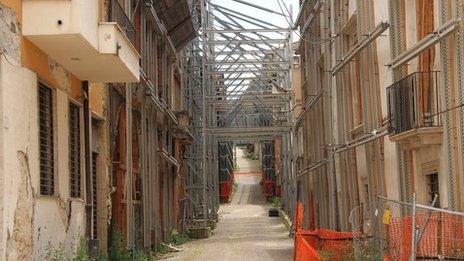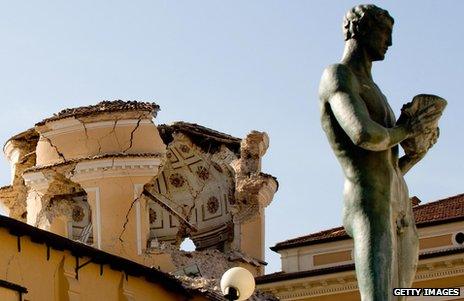L'Aquila after the earthquake: Why flags do not fly
- Published
Luisa Baldini returns to the centre of L'Aquila to see how it is frozen in time
Four years after the earthquake which shattered the Italian city of L'Aquila, there is anger over the pace of recovery.
It is as though time has stood still in the centre.
"Nouvelle Collection '09" one shop window still displays, typical of the pseudo-French sophistication that many Italians are so fond of - but the shop is empty and two naked mannequins now occupy the dark window that, until 6 April 2009 when the earthquake happened, would have displayed the latest fashions.
A total of 309 people died when the quake struck, damaging an estimated 10,000 buildings in the city and surrounding towns and villages.
Structures new and old were damaged, like the Cathedral of San Massimo which was destroyed in an earthquake in 1702 and rebuilt in the 19th Century.
On balconies and in windows of uninhabited homes, washing still hangs from some lines. It is only when you look closely that you see it is faded and twisted around the string from being exposed to the elements over the past four years.
How it defies rotting, withering and disintegrating, you might well wonder about L'Aquila itself.
'Worthy fight'

The centre of the city still lies in ruins
Street after street, the buildings are derelict, only standing because steel beams and wooden timbers are propping them up.
There is a determination to rebuild like for like, certainly in the old town.
Some 22,000 of the 70,000 people of the city who were made homeless are still unable to return to their homes and are living in rapidly built blocks of flats on the outskirts.
Some 70% of the reconstruction needed on the outskirts has been completed but the 13th-Century town centre remains crippled, guarded by the military who only allow those with authorisation to enter.
"I do want to return, of course I miss it," says Mariella Riccobono, who now lives 10 minutes outside the town.

She is among the lucky ones, for most of the new apartment blocks for the earthquake homeless are much further away. She surveys the plot where she used to live in a four-storey building. Only the foundations remain after it crumbled within seconds during the earthquake. She was pulled from the rubble alive but five of her neighbours perished.
"I miss my former life, the neighbours I grew up with, the woman who lived upstairs who used to treat me like a daughter," she says.
"I miss it and I want the L'Aquila we all know to return and be even better, I want people to come back."
She is philosophical about the time it will take to rebuild the town.
Romina Mozi has not been so patient. She says she knocked on the door of the authorities every day for over three years until she was given permission to reopen her restaurant, above which she lives with her husband and two teenage sons.
It is an oasis among dozens of empty, damaged buildings. Wiping a tear from her cheek, she says: "It's worth fighting for your home. If you give up, you're abandoning the city. We've continued paying a mortgage all this time and it's my livelihood, it's everything I've created."
'Forgotten city'
Leading the fight, or crusade as he sees it, to return this town to its former glory and more, is Mayor Massimo Cialente.
He has accused the government of forgetting about L'Aquila, and has protested by returning his symbolic tricolour mayoral sash to the president and by refusing to raise the Italian flag on any buildings.

The 2009 tragedy also left about 50,000 people homeless, with the reconstruction of houses and the city's historic centre expected to take at least 10 years.
He says the delay has been due to paralysing bureaucracy, a lack of organisation between the local and national governments and a lack of funds.
"It's also a very complex project," he explains.
"We need to build a 'smart city' with earthquake-proof structures, broadband and other facilities. It's a real challenge."
That is more easily said than done in a city where many of the buildings are centuries old, where homes are interwoven with historically important buildings and where the narrowness of the streets means cranes and other construction vehicles can only be brought in a few at a time.
Uncertain times
According to the Italian government, nearly 8bn euros (£6.8bn; $10.7bn) have already been spent on L'Aquila and the other 56 surrounding communities that were affected in the quake.

The city's cathedral was badly damaged by the quake
In Rome, the new Minister for Regional Development, Carlo Trigilia, tells me that L'Aquila is a priority for the national government.
As the most senior government minister responsible for L'Aquila, he made a fact-finding trip to the region two weeks ago and is pledging 1bn euros a year over eight years, although he says he would like to accelerate the project.
He acknowledges that in the first two years after the disaster there was a problem with the fraudulent use of L'Aquila funds, but says that that is no longer the case and that the government is keeping a close eye on where the money is going.
Nevertheless, given the complexities of rebuilding and the economic situation in Italy, not everyone is convinced that the flow of money will be either steady or sufficient to restore the soul of this medieval city within the near future.
- Published6 April 2013
- Published16 February 2013
- Published19 September 2012